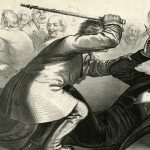 Weird Stuff
Weird Stuff  Weird Stuff
Weird Stuff  Our World
Our World 10 Ways Your Christmas Tree Is More Lit Than You Think
 Movies and TV
Movies and TV The 10 Coolest Stars to Set Sail on The Love Boat
 History
History 10 Things You Didn’t Know About the American National Anthem
 Technology
Technology Top 10 Everyday Tech Buzzwords That Hide a Darker Past
 Humans
Humans 10 Everyday Human Behaviors That Are Actually Survival Instincts
 Animals
Animals 10 Animals That Humiliated and Harmed Historical Leaders
 History
History 10 Most Influential Protests in Modern History
 Creepy
Creepy 10 More Representations of Death from Myth, Legend, and Folktale
 Technology
Technology 10 Scientific Breakthroughs of 2025 That’ll Change Everything
 Weird Stuff
Weird Stuff Ten Bizarre Facts About The Doge Meme
 Our World
Our World 10 Ways Your Christmas Tree Is More Lit Than You Think
 Movies and TV
Movies and TV The 10 Coolest Stars to Set Sail on The Love Boat
Who's Behind Listverse?

Jamie Frater
Head Editor
Jamie founded Listverse due to an insatiable desire to share fascinating, obscure, and bizarre facts. He has been a guest speaker on numerous national radio and television stations and is a five time published author.
More About Us History
History 10 Things You Didn’t Know About the American National Anthem
 Technology
Technology Top 10 Everyday Tech Buzzwords That Hide a Darker Past
 Humans
Humans 10 Everyday Human Behaviors That Are Actually Survival Instincts
 Animals
Animals 10 Animals That Humiliated and Harmed Historical Leaders
 History
History 10 Most Influential Protests in Modern History
 Creepy
Creepy 10 More Representations of Death from Myth, Legend, and Folktale
 Technology
Technology 10 Scientific Breakthroughs of 2025 That’ll Change Everything
Ten Infamous Manhunts from American History
The pursuit of a criminal who has gone on the run is always a dramatic event. Manhunts have captivated people throughout history. Historically, it was the military who conducted manhunts. Soldiers would track down defeated generals and kings to either capture or execute them. However, as society progressed into modern times, manhunts began to be conducted by law enforcement agencies. Police departments and federal agencies started to use manhunt tactics to track down notable outlaws. These manhunts often involve a coordinated effort across a vast area. Key roads would often be closely monitored or even shut down.
Manhunts can be resolved quickly, but they can also drag on for years. While any manhunt is a serious matter that involves protecting the public, some of these have left a lasting impression on the American public. The most famous of these manhunts involve dangerous criminals and an immense amount of resources. As such, they are forever ingrained in the country’s history. In this list today, you’ll learn all about some of the most famous manhunts in American history. Police scoured the country to pursue these dangerous criminals. This is the story of how these infamous outlaws were brought to justice.
Related: Top 10 Story-Worth Crimes in American History
10 Bonnie and Clyde
Clyde Barrow and Bonnie Parker were the notorious criminal couple of their time. They were admired by some for their daring exploits. But, of course, they were also ruthless murderers. During their reign of terror, the duo committed a variety of crimes, including kidnapping and bank robbery. They showed no remorse for taking the lives of anyone who got in their way. Their violent spree spanned from 1932 to 1934, during the height of the Great Depression.
During that time, many Americans were struggling to make ends meet. So it was natural that they would support bank robbers like Bonnie and Clyde. After all, the banks they stole from weren’t exactly popular among regular Americans. And so the couple’s legend only increased when cops failed to bring them to justice.
Despite their previous brushes with the law, it wasn’t until Parker was released from jail in 1932 that the couple assembled a gang of accomplices and began their really aggressive reign of horror. They terrorized five states in the mid-South and Dust Bowl area for more than three years. After one of their members was sprung from a Texas prison using machine guns, a retired Texas Ranger named Frank Hamer was asked to track them down.
The ensuing manhunt saw Hamer fail to find them time and again. For three months, the Texas Ranger struggled to come up with answers. But one day, Hamer received a tip that the couple was heading to Louisiana. His team ambushed them on a rural road and opened fire, killing them instantly. The end of Bonnie and Clyde marked the end of a violent and bloody chapter in American history.[1]
9 Pancho Villa
Most manhunts don’t turn into full-scale invasions. It’s rare that a military would ever need to cross a border into another nation to track down a killer. But that’s exactly what happened in 1916 when U.S. General John Pershing led a force of 6,000 into Mexico. They marched more than 350 miles into the country, forever blurring the line between a manhunt and an act of war. The cause of this action was due to the criminal conduct of Francisco “Pancho” Villa.
Villa had supported an insurgency during the Mexican Revolution. Soon, he found himself on the wrong side of those in power. After a difficult defeat in Mexico, he marched raiders into the United States and attacked the city of Columbus, New Mexico. There, he killed 19 Americans and set the entire town on fire.
President Woodrow Wilson ordered Pershing to lead a “punitive expedition” to bring Pancho Villa to justice. The outing led by Pershing was less than a week after the attack on Columbus. So the general never hesitated to cross the border into Mexico to get justice. Today, many historians believe Villa wanted this all along. He supposedly hoped the Americans would tip the balance of power south of the border. However, this plan backfired.
After Mexican forces attacked Pershing’s troops, the United States almost immediately recalled the general. This was because of the Zimmermann Telegram, an offer from Germany to support Mexico if it attacked the United States. The Germans wanted America to be distracted from fighting in World War I. That gambit didn’t work, though. President Wilson reassigned Pershing’s forces far away from Mexico. The troops went to Europe to fight in World War I against Germany. Villa lived on after the unsuccessful manhunt but was assassinated by another group less than a decade later.[2]
8 Eric Rudolph
The Centennial Olympic Park bombing in Atlanta on July 27, 1996, sparked a massive manhunt for the perpetrator. Initially, security guard Richard Jewell was suspected. But it was later revealed the bombings were part of a series of terrorist attacks by Eric Robert Rudolph. Rudolph had planted and detonated bombs at an Atlanta abortion clinic, a same-sex nightclub, and a women’s health clinic.
Unfortunately, Rudolph was able to evade capture for five years due to his skills as an outdoorsman. He was familiar with the woods of western North Carolina, where he had grown up. Plus, he had already scouted caves and other shelters he could use while moving around and burying supplies throughout the area.
For years, Rudolph evaded police and the FBI. Cops sent expeditions throughout the woods time and again, but they had little success figuring out where the avid outdoorsman could have gone. However, in 2003, he was finally caught while dumpster diving in the town of Murphy, North Carolina. Eagle-eyed cops swooped in and arrested him.
Eventually, he pleaded guilty during his legal proceedings in 2005. He was sentenced to four life terms in prison without the chance of parole. But none of it happened before cops luckily ended what had become a six-year mountain pass manhunt. Had Rudolph not been caught dumpster diving that day in 2003, he might never have been found.[3]
7 Ted Kaczynski
Ted Kaczynski, infamously known as the Unabomber, became the target of a manhunt in 1978. That year, he mailed the first of 16 bombs he would send over the course of the next 17 years. The bombings primarily targeted universities but also included an American Airlines flight. That led the FBI to code-name their search as UNABOMB. The acronym stood for “university and airline bombing.”
Despite causing the deaths of three people and injuring 23 more, the search for Kaczynski proved to be nearly impossible. One major obstacle was the handmade nature of his bombs. That made it all but impossible to trace their components. Additionally, Kaczynski’s reclusive lifestyle in a small, hand-built cabin without modern amenities made him difficult to locate.
However, the search for the Unabomber came to a close when the FBI published Kaczynski’s manifesto. The long, handwritten missive outlined his anti-technology beliefs. The government hoped somebody might recognize the writing and offer them a tip. Amazingly, that’s exactly what happened.
Ted’s brother David recognized the unique writing style of his brother and provided the FBI with private letters. Those messages confirmed the manifesto was written by the same person. The FBI swooped in and began to hone in on the man, thanks to the unlikely tip. Eventually, this led to the capture of Kaczynski and the end of one of the longest and most expensive manhunts in American history.[4]
6 Timothy McVeigh
The morning of April 19, 1995, is forever etched in the minds of those who witnessed the horrific event that occurred in Oklahoma City. That day, a devastating truck bomb exploded outside the Alfred P. Murrah Federal Building in the Oklahoma town. It leveled the structure and claimed the lives of 168 people.
Tragically, that included 19 young children in the on-site daycare center. Immediately, the significance of the date was not lost on investigators. April 19 marked the second anniversary of the infamous Waco siege between the Branch Davidians and federal agents, which had resulted in 80 deaths.
As the investigation unfolded, authorities quickly zeroed in on a lead. The exploding truck’s axle was found the following day. With the help of the vehicle identification number, the rental was traced back to a body shop in Kansas. Employees there were able to provide a description of the renter. That description led to the creation of a composite sketch. Soon, the sketch was revealed to be connected to the identity of the perpetrator: Timothy McVeigh.
In an unbelievable turn of events, McVeigh was already in custody. He had been arrested for carrying a concealed weapon during a traffic stop on Interstate 35 just days after the bombing. He could have been released on bail on the relatively minor charge already. However, he had been stuck in prison. Luckily, authorities finally uncovered his involvement in the deadly terror attack just hours before he would have been released.[5]
5 James Earl Ray
The assassination of Dr. Martin Luther King Jr. on April 4, 1968, was one of the most tragic and infamous moments in civil rights history. The perpetrator turned out to be a man named James Earl Ray. He was a small-time criminal who had escaped from prison the year before. On that fateful day, Ray fired a rifle from a bathroom window across the street from the Lorraine Motel in Memphis to where Dr. King was standing on a balcony.
King fell and soon died. But despite the overwhelming evidence pointing to Ray, and quick police action to surround the area and establish a perimeter, Ray managed to escape in the immediate aftermath of the shooting. For several months, he was free from justice as cops and the FBI scrambled to find him.
The manhunt for the assassin was intense and widespread. Ray initially planned to flee south to New Orleans. But after hearing about the search efforts in the media, he decided to head to Canada instead. Once across the border, he obtained a false passport and booked a flight to London. Thanks to a tip, the FBI quickly learned he had used the fake passport. Soon, they were able to track down several potential aliases.
Eventually, Ray was arrested at London’s Heathrow Airport. He had been caught while trying to board another flight to Belgium. An alert customs officer noticed Ray was carrying two passports and pulled him out of line. And that was that. Cops swooped in when they finally learned of his identity and made the arrest. Soon, Ray was extradited back to America. And with that, the end came for a nearly two-month-long search for the killer of one of America’s iconic civil rights leaders.[6]
4 Whitey Bulger
James “Whitey” Bulger was a notorious mafioso for decades in and around Boston. He controlled an organized crime empire for several decades without any repercussions. This was largely due to the fact that he was a secret informant for the FBI. That informal gig gave him access to information. It also offered protection that enabled him to operate his illegal business with impunity.
However, in 1995, Bulger’s FBI handler tipped him off about an impending arrest. That led Bulger to flee west. The FBI launched a massive international manhunt for him, but they were unable to track him down for nearly two decades. In that time, he moved to California. There, he lived openly under an assumed name with his girlfriend, Catherine Greig.
In 2011, the FBI changed its strategy. Instead of going after Bulger, they focused on capturing Greig. To do so, they targeted a female audience who may have encountered her at hair salons or cosmetic surgery offices. This tactic proved to be successful, and in June of that year, Bulger was finally arrested. He was charged with 19 mafia murders. Eventually, he was convicted of 11 of those killings. As part of his penalty, he was sentenced to two life sentences. But life ended quickly for Bulger, though.
In October 2018, he was brutally beaten to death in a maximum-security prison in West Virginia. It was later discovered that the three men who killed him had planned the murder as soon as they learned of his arrival at the facility. They sought to take down the notorious criminal and improve their own standing in the prison. With his death, Bulger’s crazy life and notorious time on the run all came to an end.[7]
3 Ted Bundy
Ted Bundy was one of the most notorious serial killers of the 20th century. He had a confirmed body count of 28 victims, but investigators now believe his real number of murders could be much higher. Some historians and investigators have estimated he may have averaged one murder per month for over four years. Regardless, he wreaked havoc all across the country throughout the 1970s. And his good looks and charming demeanor helped him avoid capture for a long time.
He was first apprehended in August 1975, though, after attempting to abduct a woman named Carol DaRonch. The next year, he was tried and convicted on charges of aggravated kidnapping. For a while, it looked as though he’d been captured, and his reign of terror ended. But this story was far from over. Bundy managed to escape prison while being transferred to Utah to stand trial for a separate murder charge. He did so by slipping out of a second-floor window at the courthouse.
Eventually, he was recaptured and placed in a more secure facility in Colorado. But this did not stop him from escaping again. The second time, he lost lots of weight over a period of time and then cut a hole in the ceiling of his cell. He wriggled out, crawled away, and was home free. The manhunt that ensued lasted for two months before police found him again. Cops all over the country frantically searched for Bundy. Unfortunately, no leads came out in the first few weeks, and it wasn’t long before he killed again.
During that time, he killed several more women. Finally, he was caught for good in February 1978. Bundy’s ability to evade the law was due to his charming and normal-looking appearance, which kept him off the radar. He also had a considerable feel for subtly altering his appearance through various means like fake casts and gaining or losing weight.[8]
2 The Beltway Snipers
The string of murders that occurred in October 2002 quickly became known as the Beltway Snipers. At first, they left law enforcement officials and the public in a state of confusion and fear. The initial killings were not immediately linked together. So the police were at a loss for a suspect or motive.
However, as more victims were found, it became clear that someone was actively hunting individuals with a high-powered sniper rifle in the Washington, D.C., area. The Beltway Snipers’ 23-day reign of terror ended up resulting in the deaths of 10 people and left three more critically injured.
In response to the ongoing threat, every law enforcement group in the region formed a “joint operations center.” The FBI established a Rapid Start Information Management System to sort and prioritize the overwhelming amount of tips received. Despite these efforts, many officers felt the system hindered their progress by overwhelming them with information. But a break finally came when the snipers, John Muhammad and Lee Boyd Malvo, called a priest in Virginia.
During the call, they referred to a homicide in Alabama. This led authorities to Malvo and, eventually, to Muhammad. A description of Muhammad’s car was circulated, and cops and the public both went to work. Soon, it was spotted at a rest stop on a highway in Maryland. Inside, the snipers were found asleep. They were arrested and eventually tried for the killings. After being found guilty, Muhammad was executed in 2009. Malvo received multiple life sentences.[9]
1 Christopher Dorner
Christopher Dorner was a veteran of both the U.S. Navy and the Los Angeles Police Department. But his law enforcement career hadn’t gone to plan. Frustrated, in 2013, he embarked on a violent vendetta against his ex-peers in the LAPD. He posted a manifesto on social media revealing his anger and frustration after being dismissed from the force.
An internal investigation had found he had fabricated a complaint to accuse his training officer of physically abusing a homeless man. Dorner felt that he was a victim of racism in the exchange leading to his dismissal. So he sought out revenge.
During a nine-day period in late January and early February 2013, he killed four people. Among those were two law enforcement officers, as well as the daughter of a retired police captain and her fiancé. He also wounded three more officers. Then, he went on the run. The manhunt for Dorner was massive and chaotic. LAPD officers were on high alert. At times during the manhunt, their communication and discipline broke down. In one infamous instance, that error led to a tragic situation where eight officers fired more than 100 rounds at three people who had no connection to Dorner.
Dorner was eventually located at a remote cabin at Big Bear Ski Resort north of Los Angeles. There, he engaged in a shootout with police. The standoff ended when the cabin caught fire from pyrotechnic tear gas canisters. Dorner’s body was later found in the charred remains of the cabin. Forensic investigators later ruled he died from a self-inflicted gunshot wound.[10]








